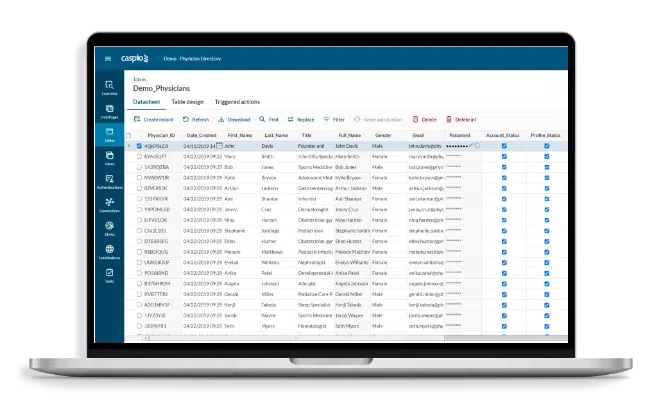No-Code Open System Data Source Development: Empowering Organizations to Develop Faster
No-Code Open System Data Source Development: Empowering Organizations to Develop Faster
Blog Article
Discover How Scalable Data Sources Can Be Used Without Coding to Enhance Your Organization Procedures
In today's fast-paced organization environment, the capacity to handle and examine information efficiently is critical. no-code. Scalable data sources, specifically when coupled with no-code services, provide a transformative approach that empowers non-technical individuals to streamline procedures.
Recognizing Scalable Databases
Scalable data sources are crucial for contemporary company procedures, enabling organizations to efficiently take care of increasing volumes of information without compromising performance. These databases are made to expand and adapt to the altering needs of an organization, guaranteeing that they can deal with bigger datasets and even more complex questions as business demands evolve.
Recognizing scalable data sources includes identifying their 2 key kinds: vertical scaling and straight scaling. Vertical scaling, or "scaling up," includes adding even more power (CPU, RAM) to an existing web server to boost performance. Alternatively, straight scaling, or "scaling out," involves adding much more web servers to distribute the lots, which often results in higher flexibility and fault resistance.
Another vital aspect is the architecture of scalable databases, which can be either non-relational or relational. Relational data sources, such as MySQL and PostgreSQL, are structured and use SQL for inquiries, while non-relational data sources, like MongoDB and Cassandra, offer more adaptability with disorganized information.
Eventually, comprehending scalable databases is essential for companies aiming to leverage information as a calculated asset, enabling them to remain competitive in an increasingly data-driven environment.

Advantages of No-Code Solutions
Opening the possibility of no-code services equips services to enhance procedures and improve performance without the requirement for considerable programming understanding. These platforms permit non-technical individuals to develop, modify, and manage databases easily, therefore equalizing accessibility to technology across groups.
Among the key advantages of no-code services is their speed of application. Businesses can swiftly deploy applications and automate processes, considerably lowering the moment invested in development cycles. This dexterity makes it possible for organizations to respond quickly to market adjustments and customer needs, fostering an one-upmanship.
Additionally, no-code platforms reduce dependence on IT departments for day-to-day jobs, enabling technical groups to concentrate on even more intricate tasks that need specialized skills. This shift not just maximizes source allocation yet additionally promotes advancement within the company.
Cost-effectiveness is an additional benefit, as no-code remedies can reduce growth and upkeep expenses. By reducing the need for coding know-how, companies can harness the capacities of their existing workforce without the overhead of hiring additional personnel.
Popular No-Code Database Tools
The surge of no-code services has brought about the development of numerous database tools that deal with services seeking performance and ease of access. These devices encourage customers with limited technological expertise to create, navigate to these guys take care of, and control data sources effortlessly.

Caspio sticks out for its capability to build web applications with no coding. It enables services to produce durable databases and release applications promptly, accommodating various sector needs. In a similar way, Flair provides user-friendly user interfaces and effective information administration abilities, enabling companies to construct custom applications customized to their process.

Use Cases in Business Procedures
Exactly how can organizations leverage database tools to enhance their procedures? Scalable databases offer companies with effective capacities to take care of and analyze data without the demand for considerable coding knowledge. These devices can improve various organization procedures, ultimately causing improved performance and performance.
One noticeable use situation is consumer connection monitoring (CRM) Organizations can make use of scalable data sources to track client interactions, preferences, and responses, making it possible for personalized communication and better service. By centralizing this info, groups can work together better and reply to customer demands in real-time.
One more considerable application is supply management. Companies can use no-code data source devices to keep an eye on stock degrees, track deliveries, and projection demand. This makes sure ideal stock degrees, minimizes waste, and decreases stockouts.
Additionally, job administration can take advantage of scalable databases by permitting teams to manage tasks, due dates, and sources in a combined platform. With real-time updates and data visualization, job supervisors can make educated choices.
Beginning With Implementation
Applying scalable databases in service procedures requires a structured technique to guarantee effective assimilation and application. The initial step is to conduct her comment is here a complete needs evaluation, determining specific service demands, data kinds, and anticipated development patterns. This fundamental understanding will certainly guide the choice of the proper data source solution.
Next, select an easy to use, no-code data source platform that aligns with your functional goals. no-code. Several modern options supply user-friendly user interfaces, enabling non-technical customers to manage information efficiently. After picking a platform, establish a clear information style that outlines just how information will certainly be organized, accessed, and kept
Training is important; make sure that employee are outfitted with the needed skills to make use of the database. Think about offering tutorials or workshops to familiarize personnel with the system's performances.
Verdict
In conclusion, the integration of scalable data sources via no-code services provides significant benefits for company operations. Ultimately, leveraging these innovations can lead to enhanced efficiency and functional performance, placing services for continual growth in an affordable landscape.
One popular no-code database tool is Airtable, which incorporates the performance of a spread sheet with the power of a data source.How can businesses take advantage of data source devices to improve their procedures? Businesses can make use of scalable databases to track consumer communications, preferences, and responses, making it possible for customized communication and much better service.Applying scalable data sources in company procedures requires a structured strategy to make sure effective integration and usage.In verdict, the combination of scalable data sources with no-code remedies offers significant advantages for company procedures.
Report this page